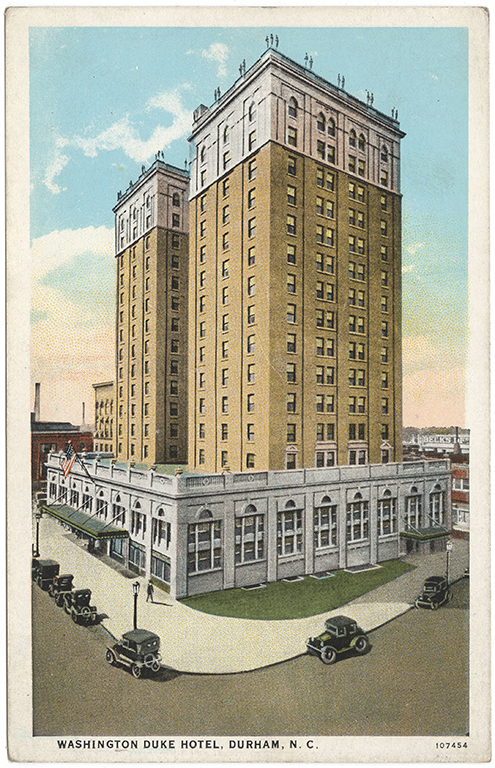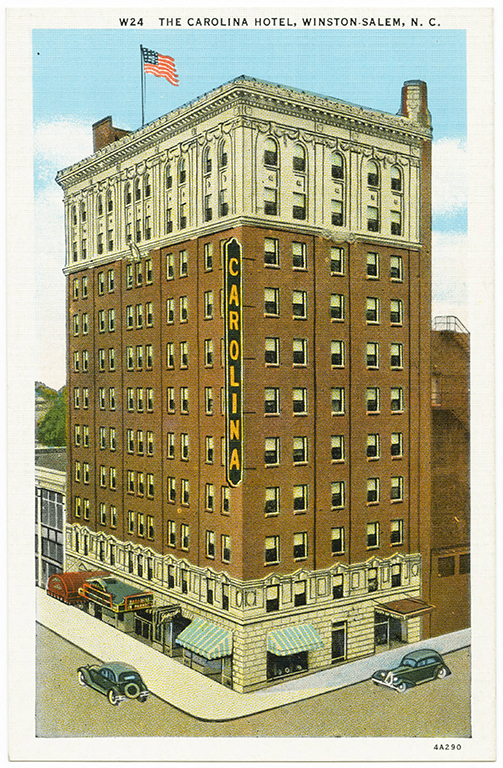Johnson, Stanhope S. (1882-1973)
Birthplace:
Lynchburg, Virginia, USA
Residences:
- Lynchburg, Virginia
Trades:
- Architect
NC Work Locations:
Building Types:
Styles & Forms:
Beaux-Arts; Georgian Revival; Neoclassical Revival
Stanhope S. Johnson (1882-1973) was a prolific Virginia architect based in Lynchburg who designed at least two notable buildings in North Carolina—the Washington Duke Hotel in Durham and the Carolina Theatre and Hotel in Winston-Salem, large and luxuriously detailed tall buildings that instantly became landmarks of their cities. He is believed to have planned other North Carolina buildings, which remain to be identified.
A native of Lynchburg, at age seventeen Johnson began working in the architectural office of Edward G. Frye. By 1909 he became a partner in the architectural firm of McLaughlin, Pettit and Johnson. Charles Pettit left the firm by 1913, and by 1917 McLaughlin and Johnson had formed independent practices. From 1925 to 1932, Johnson associated with architect Ray O. Brannan as Johnson and Brannan. Addison Staples was a draftsman and designer in Johnston’s office from 1919 to 1938. Johnson, who continued his practice into the 1960s, was considered the “dean” of Lynchburg’s architects. His work encompassed many neoclassical and Georgian Revival buildings but also modernist designs in the 1920s and 1930s.
The Stanhope S. Johnson and R. O. Brannan Collection (ca. 1900-1925) at Special Collections at Belk Library at Appalachian State University in Boone, North Carolina, comprises a small group of drawings and photographs, including a drawing and photograph of the Carolina Hotel and Theatre Building in Winston-Salem and an undated drawing for a city hall in Durham. After Johnson’s death most of his drawings were given to the Jones Memorial Library in Lynchburg.
- S. Allen Chambers, Lynchburg: An Architectural History (1981).
- Heather Fearnbach, Winston-Salem’s Architectural Heritage (2015).
- Joel A. Kostyu and Frank A. Kostyu, Durham: A Pictorial History (1978).
- “Washington Duke Hotel/Jack Tar Hotel,” Open Durham, http://opendurham.org/buildings/washington-duke-hotel-jack-tar-hotel.
- John E. Wells and Robert E. Dalton, The Virginia Architects, 1835-1955: A Biographical Dictionary (1997).
Carolina Theatre and Hotel
Contributors:Johnson and Brannon, architects; Stanhope S. Johnson, architect; John B. Pettyjohn and Company, contractors; L. B. Turner, supervising architectVariant Name(s):Stevens Center
Dates:1928-1929
Location:Winston-Salem, Forsyth CountyStreet Address:407 W. 4th St., Winston-Salem, NC
Status:Standing
Type:Commercial
Note:The 11-story skyscraper with classical base-shaft-capital format features red brick and rich neoclassical detail. Its theater, which seated nearly 2,500 people, was said to be the largest between Atlanta and Washington, D. C. when completed and was described as the first in the state with air conditioning. In the early 1980s the building was renovated as a performing arts center associated with the North Carolina School of the Arts. At the 1983 opening, Gregory Peck was the master of ceremonies and Leonard Bernstein conducted the North Carolina School of the Arts symphony.
Washington Duke Hotel
Contributors:Johnson and Brannon, architects; Stanhope S. Johnson, architectVariant Name(s):Jack Tar Hotel
Dates:1924-1925
Location:Durham, Durham CountyStreet Address:Parish St. and Market St., Durham, NC
Status:No longer standing
Type:Commercial
Images Published In:Joel A. Kostyu and Frank A. Kostyu, Durham: A Pictorial History (1978).
“Washington Duke Hotel/Jack Tar Hotel,” Open Durham, http://opendurham.org/buildings/washington-duke-hotel-jack-tar-hotel.Note:The 16-story skyscraper in classical base-shaft-capital format was built on a prominent site formerly occupied by Durham’s Academy of Music. Local papers avidly reported the progress on construction of the hotel, such as the Durham Sun of March 29, 1925, which noted the interior work nearing completion. Opened on October 21, 1925, the hotel quickly became a prime social and political center for the city. It was imploded in 1975, and its loss was mourned by many in Durham.


